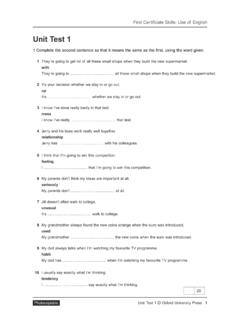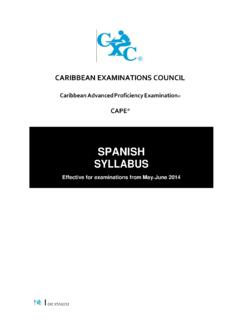Transcription of Interpretation
1 InterpretationPROFESSIONAL INTERPRETING IN THE REAL WORLDS eries Editor:Diane Teichman,Linguistic Services, Houston, Texas, USAThis series will publish books ranging from resource texts which help both interpretersin training and practising interpreters to better prepare for their assignments, totraining materials and instruction manuals for instructors of Books in the SeriesThe Interpreter's Guide to the Vehicular Accident LawsuitJosef F. BuenkerOther Books of InterestCulture Bumps: An Empirical Approach to the Translation of AllusionsRitva LeppihalmeConstructing Cultures: Essays on Literary TranslationSusan Bassnett and Andr LefevereThe Pragmatics of TranslationLeo Hickey (ed.)
2 Practical Guide for Translators (3rd edition)Geoffrey Samuelsson-BrownWritten in the Language of the Scottish NationJohn Corbett Behind Inverted Commas Translation and Anglo-German Cultural Relations in theNineteenth CenturySusanne StarkThe Rewriting of Nj ls Saga: Translation, Ideology, and Icelandic SagasJ n Karl HelgasonTime Sharing on Stage: Drama Translation in Theatre and SocietySirkku AaltonenTranslation and Nation: A Cultural Politics of EnglishnessRoger Ellis and Liz Oakley-Brown (eds)The Interpreter s ResourceMary PhelanAnnotated Texts for Translation: English GermanChristina Sch ffner with Uwe WiesemannContemporary Translation Theories (2nd Edition)Edwin GentzlerLiterary Translation: A Practical GuideClifford E.
3 LandersTranslation-mediated Communication in a Digital WorldMinako O Hagan and David AshworthFrae Ither Tongues: Essays on Modern Translations into ScottsBill Findlay (ed.)Practical Guide for Translators (4th edition)Geoffrey Samuelsson-BrownCultural Encounters in Translation from ArabicSaid Faiq (ed.)For more details of these or any other of our publications, please contact:Multilingual Matters, Frankfurt Lodge, Clevedon Hall,Victoria Road, Clevedon, BS21 7HH, INTERPRETING IN THE REAL WORLDS eries Editor: Diane TeichmanLinguistic Services, Houston, Texas, USAI nterpretationTechniques and ExercisesJames NolanMULTILINGUAL MATTERS LTDC levedon Buffalo TorontoLibrary of Congress Cataloging in Publication DataNolan, JamesInterpretation: Techniques and Exercises/James Interpreting in the Real WorldIncludes bibliographical Translating and interpreting.
4 I. Title. II. 2005418'.02 dc222004016745 British Library Cataloguing in Publication DataA catalogue entry for this book is available from the British 1-85359-791-0 (hbk)ISBN 1-85359-790-2 (pbk)Multilingual Matters LtdUK: Frankfurt Lodge, Clevedon Hall, Victoria Road, Clevedon BS21 : UTP, 2250 Military Road, Tonawanda, NY 14150, : UTP, 5201 Dufferin Street, North York, Ontario M3H 5T8, 2005 James rights reserved. No part of this work may be reproduced in any form or by anymeans without permission in writing from the by Florence Production and bound in Great Britain by the Cromwell Press .. viiIntroduction: Frequently Asked Questions .. 11 Speaking.
5 82 Preparation/Anticipating the Speaker .. 183 Complex Syntax/Compression .. 254 Word Order/Clusters .. 455 General Adverbial Clauses.. 536 Untranslatability .. 577 Figures of Speech .. 678 Argumentation .. 1179 Diction/Register .. 12710 Formal Style .. 17311 A Policy Address.. 19112 Quotations/Allusions/Transposition .. 21513 Political Discourse .. 2221111234567891011123111456789201111234 56789301111234567894041111v14 Economic Discourse .. 23615 Humor .. 25816 Latinisms .. 27517 Numbers .. 28818 Note-taking .. 294 Bibliography .. 305 Index .. 3191111234567891011123111456789201111234 56789301111234567894041111viContentsviAc knowledgmentsI am much indebted to Mr Bruce Boeglin, former training officer of theUnited Nations Interpretation Service and director of the MarymountManhattan College certificate program in Interpretation , for his encour-agement.
6 Useful comments on some of the exercises in this book also camefrom my students at Marymount Manhattan College and New YorkUniversity. Mr Jean-Luc Rostan s careful proofreading of the manuscriptand Diane Teichman s editorial guidance are highly appreciated. And nowords can express my gratitude to my wife Adele, without whosepatience and moral support this book would not have been : Frequently Asked QuestionsWhy This Book?Over recent decades the explosive growth of globalization and regionalintegration has fueled parallel growth in multi-lingual conference interpreting has come of age as a profession, inter-preter training programs have had varied success, pointing to the need for an instructional manual which covers the subject book seeks to fill that need by providing a structured syllabus and an overview of Interpretation accompanied by exercises, developed forthe classroom, in the main aspects of the art.
7 It is meant to serve as a prac-tical guide for interpreters and as a complement to interpreter trainingprograms, particularly those for students preparing for conference interpreting in international governmental and business is assumed students have mastered their active and passive workinglanguages and the fundamentals of translation. Those exercises whichdeal with lexicon focus on expanding the student s range of expression inorder to build vocabulary to the level needed for conference texts used in the exercises have been selected both to illustrate var-ious aspects of translation and Interpretation and to introduce the studentto the wide range of topics and perspectives that arise in the internationalfora where conference interpreters to Use this BookInterpretation cannot be learned from a book alone, but only througha combination of study and steady practice.
8 However, it is hoped that theexercises in this book will help the student interpreter determine whattechniques she or he needs to concentrate on. Although Interpretation is an oral skill, it contains an element of composition. Consequently, thewriting exercises in this book should not be the sake of brevity, the treatment of subjects and techniques in thisbook is somewhat arbitrarily divided and some subjects are treatedtogether in one chapter. The chapters need not be followed strictly insequence and can be taken up in any order that the instructor or studentfinds appropriate, although it is strongly recommended that none beomitted from a comprehensive introductory course .
9 The skills introducedearlier in the book ( developing confidence as a public speaker) arethose which are most necessary to a professional interpreter or whichusually take longer for most students to master; those presented later inthe book ( transposing literary allusions) are techniques which are lessoften needed in practice or which interpreters can gradually acquireoutside the classroom through experience and study. Most of the exer-cises can be done in class and/or as homework. Some require the use oftape recorders. Although the working languages used in these exercisesare English, French, and spanish , most of the exercises can be adapted toother working is Interpretation ?
10 Interpretation can be defined in a nutshell as conveying usefulness stems from the fact that a speaker s meaning is bestexpressed in his or her native tongue but is best understood in thelanguages of the addition, the respect shown by addressing an interlocutor in thatperson s own language is conducive to successful diplomacy or negotia-tion. For example, US President John F. Kennedy undertook the task ofmastering French specifically with a view to negotiating with FrenchPresident Charles de Gaulle. But not all statesmen and diplomats havethe time, energy, or linguistic talent to master the language of each partywith whom they must speak.




